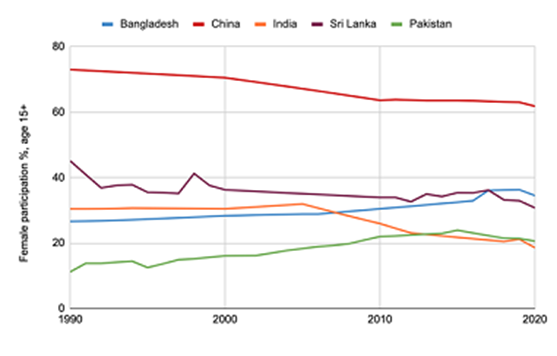According to World Bank estimates, India has one of the lowest female labour force participation rate in India which had fallen to 20.3% in 2019 from more than 26% in 2005, compared with 30.5% in neighbouring country Bangladesh and 33.7% in Sri Lanka. Most employed women in India are in low-skilled work, such as farm and factory labour and domestic help, sectors that have scourged by the pandemic.

The unemployment rate among women touched 15.8%, compared with 12.6% among male workers during 3 months that ended in September 2020, the latest quarter for which data was released. The critical low number of female workforces is due to men who have been considered to foster the economic produce of his family, where in the Indian labour laws in India which also only defines the term “workman”. The first Charter was passed in Bombay in 1929 for women who worked in textile industries.
The 1st Central Act called the Mines Maternity Benefit Act, 1941 was enacted to provide payment of maternity benefit to women at rate of Rs. 1/2 per day for a period of 4 weeks before and 4 weeks after the delivery. After which Maternity benefit was brought into horizon of the Employees’ State Insurance Act, 1948 where a woman is entitled to maternity benefit after fulfilling the minimum contributory condition. Maternity Benefits emerged as a stronger issue after the adoption of Constitution in 1950.
There are lot of benefits enacted for the women which were introduced under the Constitution of India for the benefit of female, i.e. article 15, article 39, article 42, article 46 and article 47.
HIGHLIGHTS FROM THE PARLIAMENTARY SESSION
Parliamentary Affairs Minister Ananth Kumar had labelled the bill as a “priority” for the government. The (Amendment) Bill, 2016 was passed in Rajya Sabha on 11 August 2016 and in Lok Sabha on 9 March 2017. Eloquent speeches in the Lok Sabha had 53 MPs, including 11 women members, when the Maternity Benefit (Amendment) Bill, 2016, came up for discussion in the Lok Sabha, where speakers had appreciated the amendments but some members had also put forward their inputs during the Parliamentary Monsoon Session. Following are the few recommendations taken up in the Parliamentary Minutes, suggested in respect to the Bill, which are summarised below:
- The emphasize should be on the 90% of our women who are actually working in the unorganized sector and it is only 1.8 million of the pregnant ladies in the country that will actually benefit from this new legislation. It is because, 90% of the women who work, who are part of the labour force, work in the unorganized sector, no benefit has been created for them.
- Concept of Paternity Leave to be made mandatory which is still not effective in India.
- Clarification was sought on why only 12 weeks maternity leave to women on bearing her 3rd or 4th child? Was this done keeping in view the population explosion taking place in the country.
- The maternity leave period in India was compared with UK an Australia where a maternity leave for 52 weeks is granted for women. By way of increasing the maternity leave upto 26 weeks at least we have tried to reach the half-way of this benchmark.
- To divide the period of 26 weeks off at different times instead of taking it all at once.
- Creche facility to be made mandatory whether it is 25 employees or 30 employees.
- The question which was raised basis the criteria where there are 50 employees and more, there is a requirement of a crèche which is mandatory, “Would it be better if all the 50 employees were men, there would be no requirement for a creche?” So, the criteria should be rephrased to say, if any establishment has 5 women or more, 3 women or more or even 1 woman, that is when a requirement of a crèche should become mandatory. Otherwise, in an establishment of 50 male employees, how can it be mandatory?
After several discussions, bill received an assent from President of India on 27 March, 2017 where the motion was adopted through which Maternity Benefit (Amendment) Bill became an Act.
OBJECTIVES OF THE ACT
Even after the maternity benefit was available to all the contributing employees under the ESIC Act, the Central Government enacted the legislation to include even those women who are not included under the conditions and wage-ceiling, therefore the Maternity Benefit Act, 1961 was enacted with objectives as follows:
- To protect the dignity of women’s motherhood by enabling her with complete health care to her and her child.
- To assure that women spend quality time with her child without worrying about she losing her job or livelihood.
- To safeguard working women and their rights to remain self-reliant and economically independent, maternity benefits are required.
Maternity Benefit Amendment Act, 2017
The Bill was passed by the Parliament in order to amend the Act of 2016. It received an assent from President of India on 27th March, 2017 and the Maternity Benefit (Amendment) Act, 2017 came into force. The provisions of this Act are effective from 1st April 2017. The Ministry of Labour and Employment has issued further clarifications also under Maternity Benefit (Amendment) Act, 2017 – Clarifications on 12th April, 2017 to clarify the numerous queries.
APPLICABILITY & ELIGIBILITY OF THE ACT
Section 2 of the Act states that the Act is applicable on:
- To all the establishments employing 10 or more than 10 persons in any capacity directly or through any agency i.e., either on contractual basis or as consultant etc in the organised sector (explained in Clarifications) in Factories, Mines, Plantation, Shops & Establishments and other entities.
- Establishments employing 50 or more employees are also required to provide crèche facilities, either separately or along with common facilities within a prescribed distance.
- To be eligible for maternity benefit, a woman must have been working as an employee in an establishment for a period of at least 80 days within the past 12 months. Payment during the leave period is based on the average daily wage for the period of actual absence.
COMPLIANCES OF AN EMPLOYER & EMPLOYEE IN THREE STAGES OF MATERNITY LEAVE
| COMPLIANCES OF AN EMPLOYER | ||
|---|---|---|
| SCENARIOS | Questions | Provisions |
| PRE-MATERNITY PERIOD | How long is the Maternity Leave for? | Section 5(3) states that Maternity leave available to working women has increased from 12 weeks to 26 weeks for the first 2 children and maternity leave for children beyond the first 2 will continue to be 12 weeks. |
| Is women allowed to know her Maternity Benefits? | Every establishment shall intimate it to the women hiring in writing or electronically about every benefit they can avail under the Act. | |
| DURING MATERNITY PERIOD | What is the period of break in case of Miscarriage? | Section 9 states that in case of miscarriage or medical termination of pregnancy, a woman shall be entitled to leave with wages for 6 weeks as maternity benefit on the production of proof of medical documents. |
| What is the period of break in case women takes leave with wages for tubectomy operation? | In case of tubectomy operation, a woman shall be entitled to leave with wages at the rate of maternity benefit for a period of 2 weeks immediately following the day of her tubectomy operation, on production of proof stated in Section 9A. | |
| Can women be barred or dismissed during pregnancy? | Section 12 emphasizes that any dismissal or discharge of a women during the pregnancy is unlawful and such employer can be punished under Section 21 of the Act. However, in cases of gross misconduct, the employer can take necessary actions as per the defined disciplinary policy of the Company. | |
| POST MATERNITY PERIOD | What is the time-span of Maternity leave for Adoptive or Commissiong Mothers? | Section 5(4) provides Maternity leave of 12 weeks to be available to a woman who is legally adopting a child below the age of 3 months as well to the commissioning mothers, who are defined as biological mother who uses her egg to create an embryo planted in any other woman. The 12 weeks of maternity benefit will be calculated from the date the child is handed over to adoptive or commissioning mother. |
| After Maternity Leave, can women be allowed to work from home? | Section 5(5) ensures that women should be allowed to work from home if the nature of work is assignable to do so. By a mutual agreement, this can be decided between the employer and an employee but this is not a right given to a women. | |
| In which conditions women will have access to the creche for her child? | Every establishment with more than 50 employees shall have the crèche facilities for working mothers and such mothers will be permitted to make 4 visits to the crèche during working hours which shall be inclusive of the rest period prescribed to a woman by the establishment, as stated in Section 11A(1). | |
| IN ALL STAGES | What are the provisions for punishment or penalty for employer who contravenes these laws? | Section 21 states the penalty if the employer fails to pay the amount, then he shall be punished in accordance with provisions of the Act. There shall be imprisonment for not less than 3 months and extendable up to 1 year, with a fine, not less than Rs.2000 which may extend up to Rs.5000. |
| COMPLIANCES OF AN EMPLOYEE | ||
| PRE-MATERNITY PERIOD | How can a woman employee claim for its maternity benefit? | Section 6 of the Act states that women shall give notice in writing to her employer, stating that her maternity benefit and mention the person as she may nominate in the notice Such notice shall state the date from which she will be absent from work, not being a date earlier than 6 weeks from the date of her expected delivery. If a woman has not given the notice while she was pregnant she may give such notice as soon as possible after the delivery. On receipt of the notice the employer shall permit such woman to be absent from work during the period for which she receives maternity benefit. |
| DURING / POST MATERNITY PERIOD | How can woman employee claim benefit and other leaves in case of illness arising out of pregnancy, delivery, premature birth of child, or miscarriage. | Under Section 9 & 10, woman has to provide a proof of miscarriage or any other illness which arises out of pregnancy. |
CASE STUDIES BASED ON CERTAIN IMPORTANT QUESTIONS WHICH CAN BE RAISED
Question 1: Does Surrogate Mother or Intended Mother get maternity leave and how does it work? Would a woman employee who has had a child through surrogacy be entitled to maternity leave?
Answer: Prior to the Maternity Benefit Amendment Act of 2017 rights of surrogate mothers were not acknowledged. With effect from 1st April 2017, Commissioning and Adopting mothers who has adopted a child below 3 months of age shall be entitled to 12 weeks of maternity benefit from the date the child is handed over to them whereas if a woman has a child biologically, gets 26 weeks of the same leave.
Due to such discriminatory and arbitrary statutory provisions detailing the maternity leave , PIL also has been filed by Hamsaanandini in her case Hamsaanandini Nanduri Vs Union of India 2021 in the Supreme Court challenging the Constitutional validity of Section 5(4) of the Maternity Benefit Act, 1961 which lays down that:
- Adoptive mothers will be eligible for maternity leave only if they adopt children who are less than 3 months old.
- She has also objected to the period of maternity leave as an adoptive mother gets 12 weeks, while a biological mother is granted 26 weeks.
The Supreme Court sought the response of the Central government on the plea. A response from the government is awaited.
Question 2: As per law, can woman be a surrogate mother only once in a lifetime? What happens if she does it again?
Answer: In 2006, the Indian Council of Medical Research (ICMR) published guidelines for accreditation, supervision and regulation of ART clinics in India which has stated that No woman may act as a surrogate more than three times in her lifetime.
Conclusion:
According to the World Policy Center, the number of countries extending at least 14 weeks of leave has been steadily rising since 1995. Compared to other countries like Singapore, China, Australia- India has the maximum weeks off during the Maternity period. If we convert that into percentage then India is offering 62% out of 100%, Singapore is offering 38% out of 100% and China is offering 33% out of 100%.Therefore, INDIA is giving a reasonable and fair level of maternity leave for women employees.
Maternity Benefit Act,1961 is a godsend legislation for a working women within the sense that they don’t have job insecurity during their maternity period. The Act aims at striking equilibrium between social and economic justice for women who are mothers.
Source: Report by Director Centre for Social Research
Disclaimer
The information provided in this article is intended for general informational purposes only and should not be construed as legal advice. The content of this article is not intended to create and receipt of it does not constitute any relationship. Readers should not act upon this information without seeking professional legal counsel.


